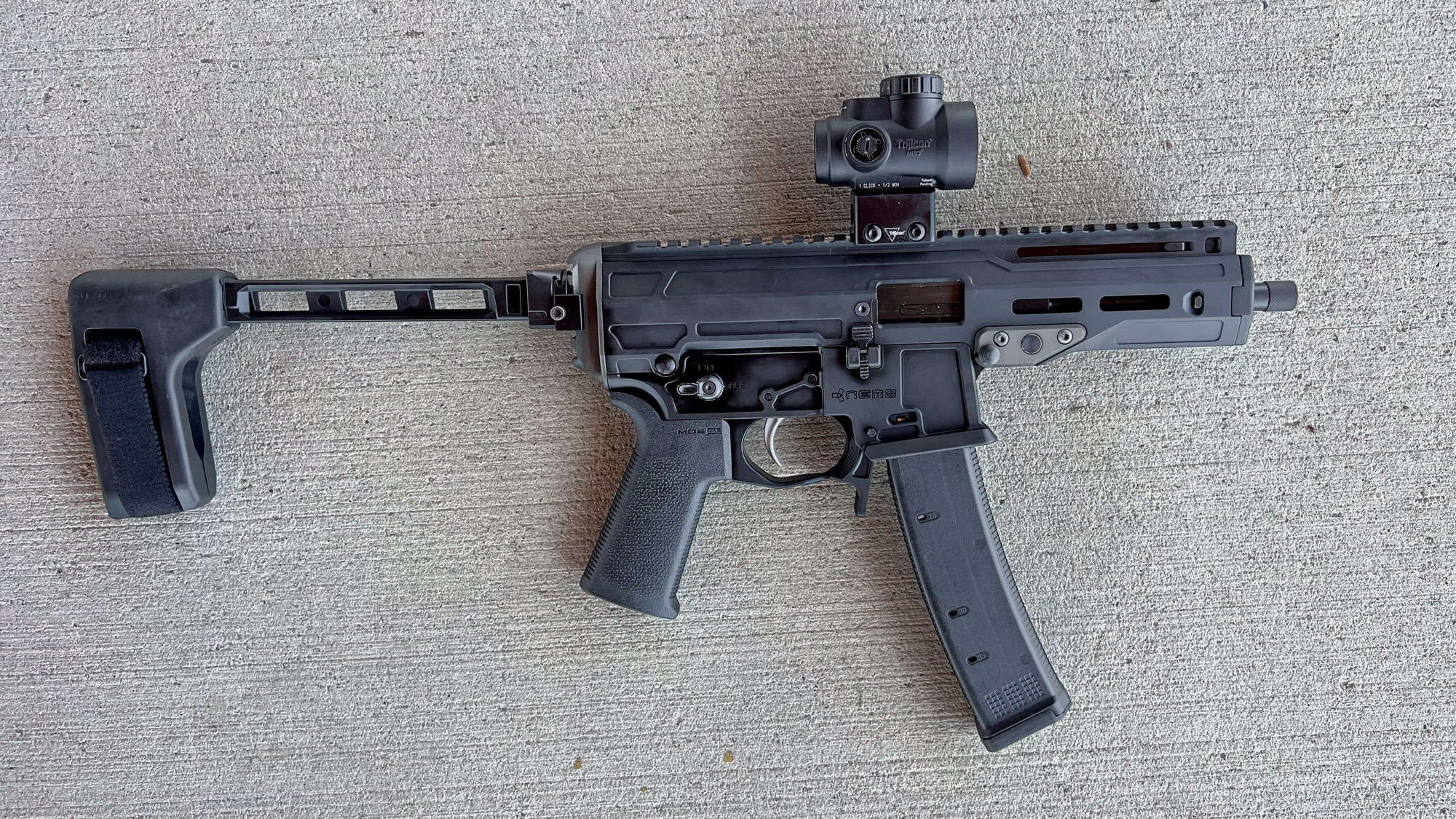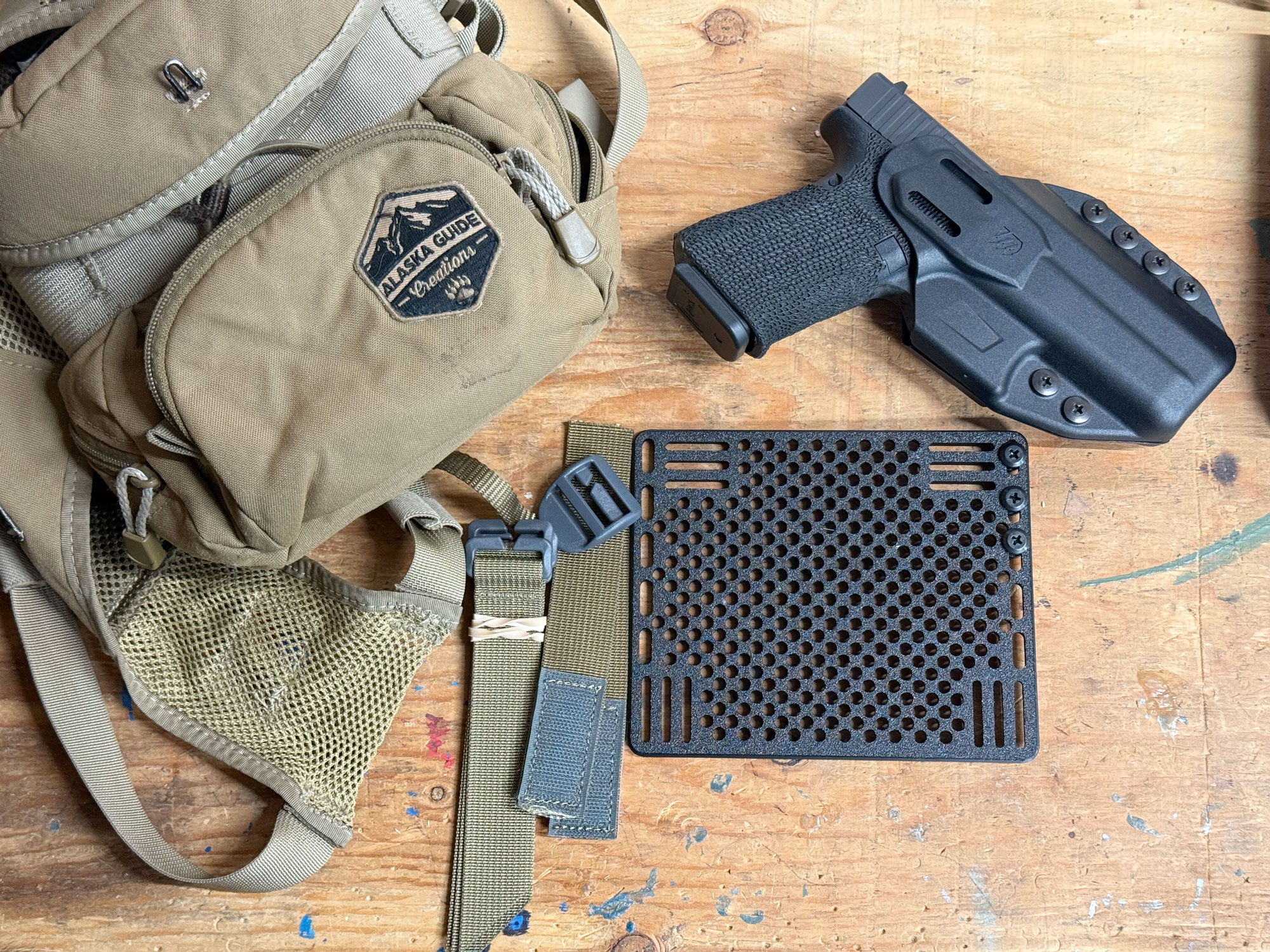Nemo Arms Mongoose Review | Outdoor Life

The Nemo Arms Mongoose is a handy 9mm PCC that is cleverly engineered, well made, and — most important — accurate and fun to shoot. I’ve put just over 300 rounds through my sample, and it lives up to its scrappy and fierce pint-sized namesake.
The design incorporates many AR-platform features but does so with a few unique twists. For me, these under-the-hood elements, which I’ll expound on in a bit, add to the Mongoose’s charm. Its main appeal, however, is how it recoils so softly despite its light weight and compact dimensions.
John B. Snow
See It
Pros
- Compact, lightweight, and portable
- Ergonomic and ambidextrous controls
- Easy to operate, mild felt recoil
Specs
- Pricey
- Folder stiff to open and close
- No sling attachment
Specs
-
Action:
Semi-auto, Browning short recoil -
Cartridge:
9mm -
Capacity:
35 -
Barrel:
5.88 inches, 1:10 twist, threaded 1/2-28 -
Weight:
4 pounds, 3.8 ounces -
Trigger:
4 pounds, 12 ounces -
Length:
23 1/4 inches (14 1/2 inches folded) -
Price:
$2699
Key Features
-
Aluminum upper and lower -
SB Tactical FS1913 brace -
Magpul 35-round CZ Scorpion EV9 magazine -
Full-length Pic rail -
Multiple M-Lok attachment points -
Captured takedown pins
Where the Nemo Mongoose Fits In
The world of pistol caliber carbines (PCCs) is sharply divided by price. The majority cost less than $1,000 and include many appealing options for plinking, home defense, and competition. Among these are the Ruger PC Carbine, Extar EP9, Smith & Wesson FPC, KelTec Sub2000, and the love-it-or-hate-it Highpoint Carbine.
There are a lot of well-known PCCs in the $1000 to $1800 range, too, such as the Sig MPX, CZ Scorpion, CMMG Banshee, and the recently released Springfield Armory Kuna. (Some of these will go for more depending on the specific model.)
And lastly, we have the premium PCCs, the high-performance superstars of the category with price tags to match. The B&T APC9 G, Angstadt Arms MDP-9 Gen 2, H&K SP5, and the JP5 are among the standouts. At just under $2700, the Mongoose seeks to elbow its way into this crowd.
Nemo Mongoose’s Short Recoil Action
As a premium-priced PCC, fans of the category are going to pick apart the Mongoose to see how it stacks up against its peer group. The first thing that might raise eyebrows is the Mongoose’s operating system, which uses Browning’s short recoil tilt-barrel design that’s ubiquitous with semi-auto handguns. While this is an utterly reliable and time-tested system, most of the top PCCs (and many of the mid-priced ones as well) have delayed-roller blowback actions, which is considered the gold standard. The reason for this is the H&K MP5 is a delayed-roller blowback and, as the world’s most esteemed submachine gun, it’s what every PCC wants to be when it grows up.
More specifically, delayed-roller blowback actions are known for their smoother recoil cycle, better accuracy potential, being more suppressor friendly, and being lighter than direct blowback systems, which is the most common type of the many submachine gun actions.
(As a side note, direct blowback actions have no bolt lockup or recoil dampening system, so they rely only on the recoil spring and mass of the bolt, which generates heavier felt recoil.)
While delayed-roller blowbacks have a great track record and undeniable street cred, a short recoil semi-auto has some advantages: they are simpler (fewer parts), less expensive to make, and can weigh even less than a delayed-roller blowback action. The reasonable concern is whether this design can manage recoil as well as a delayed-roller blowback action. In the case of the Mongoose, the answer to that is yes. Despite being one of the lightest PCCs on the market, the recoil impulse is mild, with no sensation of bolt-slap or much muzzle rise.
If you want to run the Nemo Mongoose suppressed (and who wouldn’t), just be aware that you’ll need a can with a recoil booster for reliable operation. All things being equal, a delayed-roller blowback gun will be more forgiving with a silencer.
AR Design Elements
The Mongoose has an upper and lower joined by two retaining pins, just as you’d see on an AR-style rifle. Both the upper and lower are made of aluminum — the lower is machined from a billet, while the upper is an extruded piece. Many PCCs have polymer lowers, and not that there’s anything wrong with that, but the billet-machined lower is one reason it costs more.
Other elements borrowed from ARs include the ambidextrous bolt release tabs, the ambi two-position 90-degree safety, and the Magpul A2 style grip. A notable departure is the magazine release, which is a large tab surrounding the forward part of the trigger guard.
I really like the oversized magazine release, which is well-positioned and shaped for easy activation by either the trigger finger or the support hand thumb. The Nemo Mongoose runs CZ Scorpion style magazines, which are double stack sticks that hold 35 rounds. They are easy to load (though I was glad for my Lulu loader for rounds 30 to 35, because the follower spring does get stiff) and readily available. One complaint I had was that it only comes with a single Magpul 35 EV magazine, which cuts down on the fun, but you can buy extras for $20 each.
Modified AR Trigger
The trigger is also an AR-type and, in theory, you can drop any AR-compatible trigger into the gun. But Nemo did modify the trigger slightly, cutting some weight from the hammer mass and going with a lighter spring to improve reliability. So, if you do put in another trigger, you’ll want to thoroughly test it with whatever ammo you plan to use. The trigger pull on my sample measured 4 pounds 12 ounces, which is a reasonable weight for a PCC. The trigger has a hint of mush — I wouldn’t go so far as to say creep — that would be distracting on a precision rifle but is acceptable for this type of PDW (personal defense weapon).
Nemo Mongoose Accuracy
I don’t think the trigger held the Mongoose back in the accuracy department. I tested the PCC with two types of ammo, gathering 20-shot groups at 15 yards using a bag on a tripod for support. Of the two loads, the Staccato Match 136-gr. OTM performed best, but the Hornady Steel Match 125-gr. HAP did fine as well.
| Ammo | Distance | 5-Shot Group Avg. | MV (fps) | ES (fps) | SD (fps) |
|---|---|---|---|---|---|
| Staccato 136-gr OTM | 15 yd. | 1.232 in. | 1037 | 29.7 | 6.7 |
| Hornady 125-gr HAP | 15 yd. | 1.457 in. | 1198 | 70.8 | 18.2 |
Reliability
One appeal of any 9mm firearm is the broad, readily available, and often affordable, selection of ammunition. I put around 10 different loads through the Mongoose, covering everything from 115- to 147-grain bullets. This included +P loads, premium defensive rounds, cheap aluminum cased stuff, FMJs, polymer-coated ammunition — the works. The Mongoose ran everything like a champ with one exception: Staccato’s 136-grain Match Ammunition, which is one of our baseline selections for testing accuracy, as you saw in the chart above.
The Staccato ammo is good stuff, which is why we use it to assess accuracy. The rounds are a bit longer than most, both in terms of overall length (OAL) and case length. The spec for 9mm case length is .744 to .754 inches, and this matters because the case neck is what the round headspaces off. The cases on my Staccato ammo measure .750 inches, .004 inches shorter than the max allowable length, so they are still within the SAAMI standard. That said, that’s longer than the cases on all the other ammo I used, which measured from .7395 to .748 inches, with most being .746 or .747 inches.
When I tried to chamber the Staccato ammo manually by racking the charging handle or using the bolt release tab the bolt would close but evidently not enough as the hammer didn’t generate enough energy to fire the round. To me this indicates a potential headspace issue where the necks are getting crammed into the front of the chamber.
That said, if I loaded a magazine with the Staccato ammo, and topped it off with a different type of ammo, the gun would cycle and run fine. The movement of the bolt under recoil was enough to allow the Staccato ammo to work, which is how I was able to aggregate the accuracy data.
Another tell-tale sign in support of my hypothesis is that whenever I went to clear the gun with a live round of the Staccato ammo in the chamber, the charging handle required a lot of extra force to extract the round. It didn’t exhibit the same behavior with the other ammo I shot.
Running the Nemo Arms Mongoose
This is an amazingly fun gun to shoot. As I mentioned, the felt recoil is super soft and I found it easy to control. I could place single shots on steel at 50 to 100 yards with reasonable accuracy, and, when I wanted to turn up the heat, was able to dump rounds quickly at closer ranges while keeping the dot on my Trijicon MRO steady. The layout of the AR controls made running the Mongoose as comfortable as slipping into a pair of favorite shoes.
The empties cleared the action without fail, thanks to the stout ejector. And inserting and removing the magazine couldn’t have been smoother or more intuitive.
The folding brace attaches to a small Pic rail on the rear of the upper. It took a little while for me to break in the hinge, which locks up tight but was sometimes difficult to open and close at first. I’m not sure how many cycles I put the brace through, but it operates more smoothly now.
One thing not included in the Mongoose’s feature set is a sling attachment point. That’s not a huge deal, but it would be nice to have a QD cup somewhere on the rear half of the gun.
Nemo Mongoose’s Cool Features
The flared magwell is one of the many cool features incorporated into this PCC and, coupled with the ergonomic mag release, lets you run the Mongoose like a pro. The magwell has a small window machined on either side that aligns with the 10-round indicator on the Magpul magazine. This is a nice touch to show you know at a glance when there are more (or less) than 10 rounds remaining.
Another smart design element is the steel shell deflector located at the rear of the ejection port. This insert, held in place by a Torx fastener, protects the aluminum upper from getting dinged by the ejected brass.
A close look at the bolt face on the Mongoose shows that it is a recessed oval surrounding the case head. Nemo uses an EDM process to machine that shape, which is more complex and costly to make than the bolt on a typical semi-auto handgun. It offers more surface area for the case head to bear against, augmenting reliability.
If you want to mount any accessories to the Mongoose, the upper has two M-Lok slots on each side and the bottom for six total giving plenty of options for a forward grip, lights, lasers, or whatever your heart desires.
In addition to the aforementioned ambidextrous controls, the non-reciprocating charging handle can be swapped from one side to the other easily, so the gun is lefty-friendly in that aspect too.
A final cool feature I’ll highlight are the swappable front caps the Mongoose comes with. One sits flush against the upper, leaving the threaded muzzle on the barrel exposed to easily attach a suppressor. The other looks like a compensator of sorts, enclosing the muzzle. They are held in place by spring-loaded tabs on either side. To remove them just press down on the tabs while letting the bolt fly forward to dislodge the cap. Note that the caps are ornamental and not integral to the Mongoose’s ability to operate.
From a visual and functional standpoint, I prefer the flat-faced cap. With the compensator attached the gun is a bit louder and I don’t think it looks as good, though it does give the Mongoose a space gun vibe.
Compact and Portable
With the brace closed the Nemo Arms Mongoose measures just 14.5 inches and it tips the scales at 4 pounds, 10 ounces with the Trijicon MRO aboard. In its folded configuration it is easy to transport in a bag or stash in a vehicle. For a portable PDW and truck gun it is an excellent option.
Final Thoughts
I’ve really taken a shine to the Nemo Mongoose. It’s premium-priced but I think it has the quality and functionality to justify the cost. One thing that differentiates from its peers is that it doesn’t have a combat SMG variant — like B&T APC9 and H&K SP5 — nor is it a competition race gun, like the JP5. In any event it has carved out a spot in the high-end PCC market and gives shooters another option when looking for a top-end PDW.
Read the full article here








